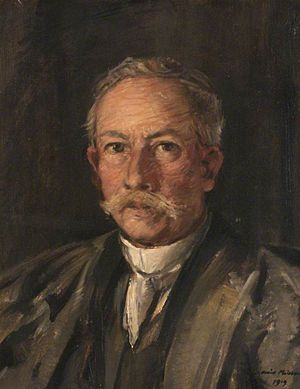Hans Friedrich Gadow facts for kids
Hans Friedrich Gadow (born March 8, 1855 – died May 16, 1928) was a scientist from Germany who studied birds. He was known as an ornithologist. He moved to Britain and did important work there. His ideas helped other scientists, like Alexander Wetmore, to sort and understand different kinds of birds.
Early Life and Education
Hans Gadow was born in a place called Stary Kraków in Pomerania. His father worked as an inspector for the Prussian royal forests. Hans went to different universities to study, including Berlin, Jena, and Heidelberg.
At Jena University, he studied with a famous scientist named Ernst Haeckel. At Heidelberg University, he learned from an expert in anatomy, Karl Gegenbaur. Anatomy is the study of the body's structure.
Working with Birds
In 1880, after finishing his studies, Gadow traveled to the Natural History Museum in London. He was asked to help with a big project called the Catalogue of Birds. This was a huge list of all the birds known at the time.
Gadow created a new way to group bird orders and families. His method was different because it looked at how birds were related through their body parts and features. This idea is called phylogenetic classification. He used studies by Max Fürbringer to help him. This new way of grouping birds was used by other scientists for many years, from the 1930s to the 1960s.
Hans Gadow wrote two parts of the bird catalogue himself. He wrote about birds like the titmice, shrikes, and nuthatches in Volume VIII. He also wrote about sunbirds and honeyeaters in Volume IX.
Life in Britain
In 1884, Gadow took over from Osbert Salvin as the Curator of the Strickland Collection at Cambridge University. This collection holds many important bird specimens. He also became a teacher there, giving lessons on the structure of animals with backbones, called vertebrates.
Gadow became a member of the British Ornithologists' Union in 1881. This is a group for people who study birds. In 1892, he became a member of the Royal Society, which is a very old and respected scientific group. He became a British citizen in 1882. He married Clara Maud Paget, whose father was Sir George E. Paget.
Travels and Books
In 1895 and 1896, Hans Gadow and his wife went on two trips. They traveled across northern Spain, from the Basque Country all the way to Galicia.
In 1897, Gadow published a book about their travels called In Northern Spain. This book shared many interesting things they saw. It included observations about the land (geography), the people and their cultures (ethnography), and the animals (fauna) and plants (flora) they found.
Gadow also wrote other important books. These included Classification of the Vertebrata (1898), which was about how animals with backbones are grouped. He also translated a book by Ernst Haeckel called The Last Link (1898). He wrote articles about anatomy for Alfred Newton's Dictionary of Birds.
Legacy
Hans Gadow's work is remembered in the scientific names of three types of lizards found in Mexico. These lizards are called Abronia gadovii, Anolis gadovii, and Urosaurus gadovi. His wife, Clara Maud Gadow, is also remembered. One type of Mexican lizard is named after her: Sceloporus gadoviae.


